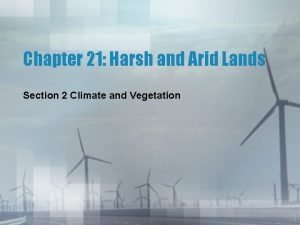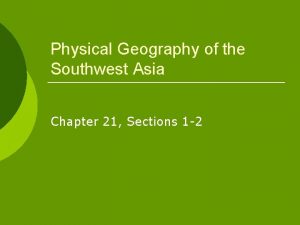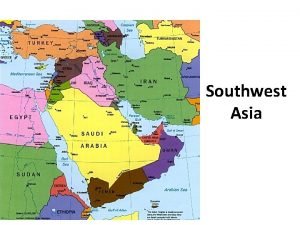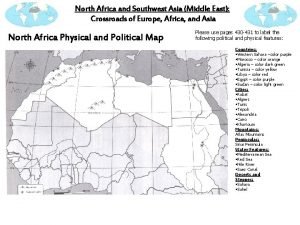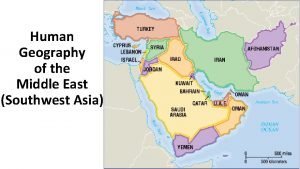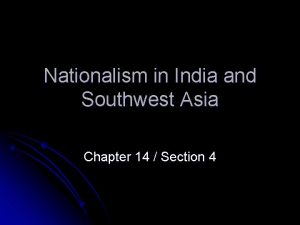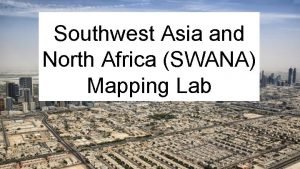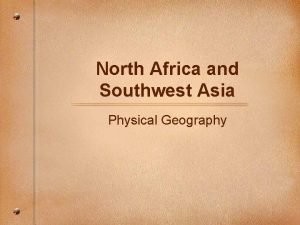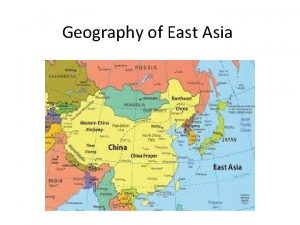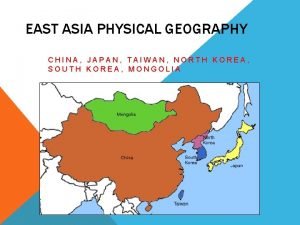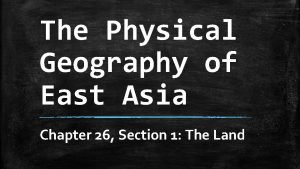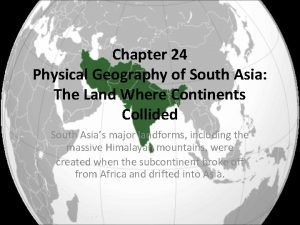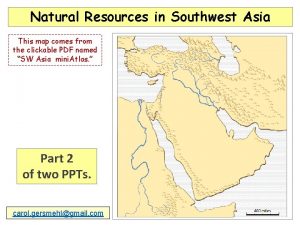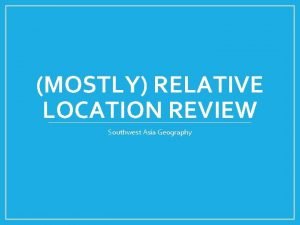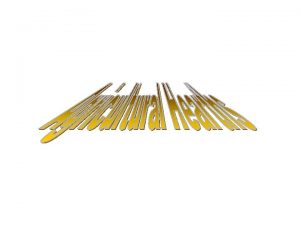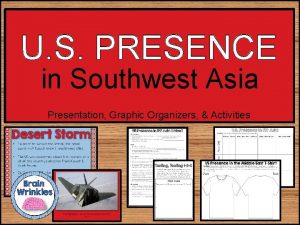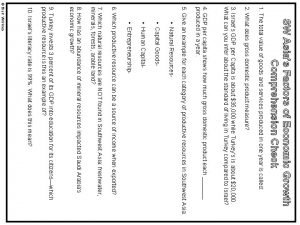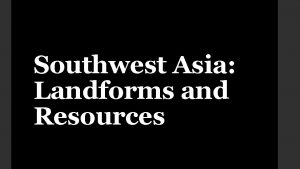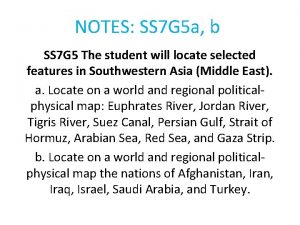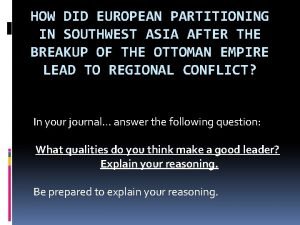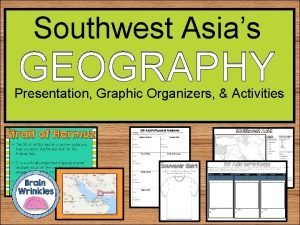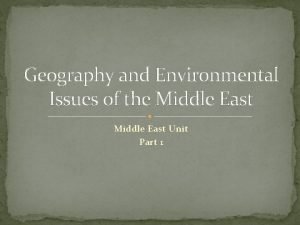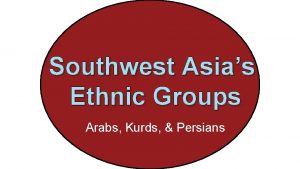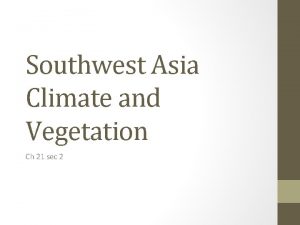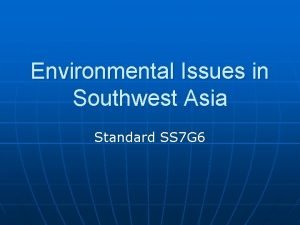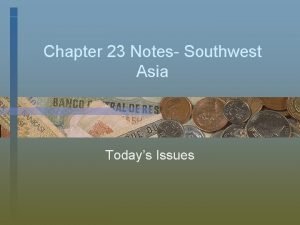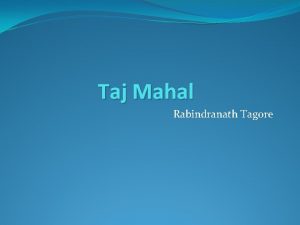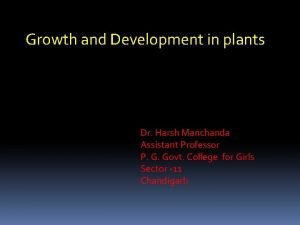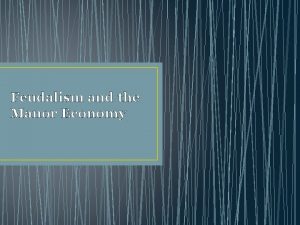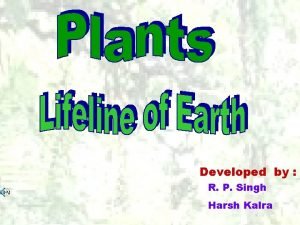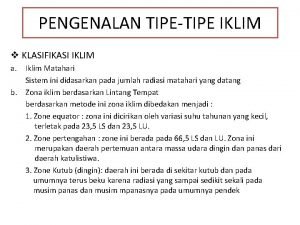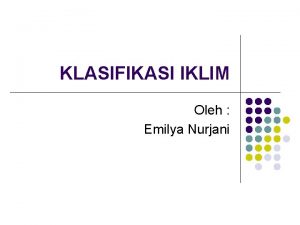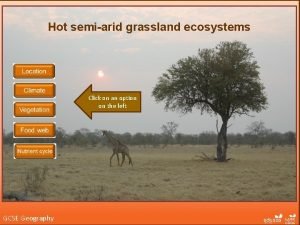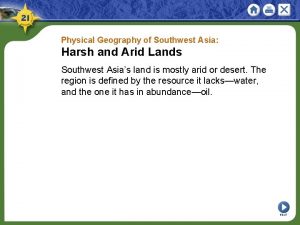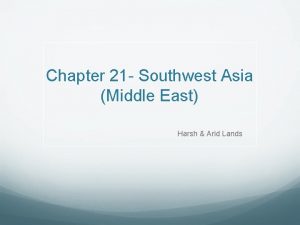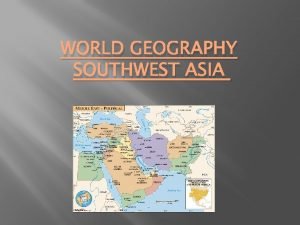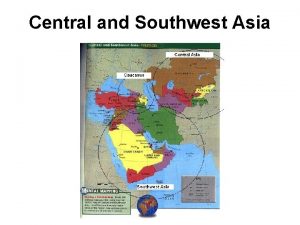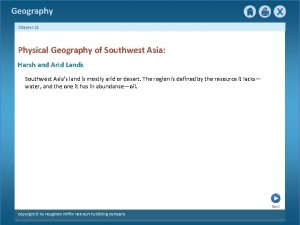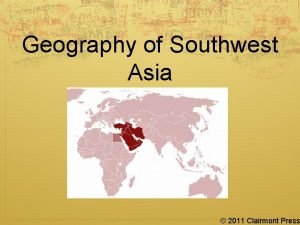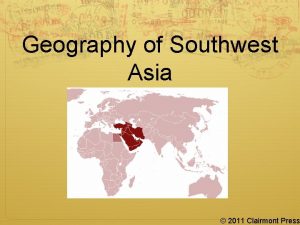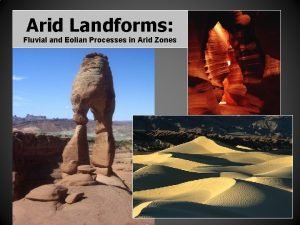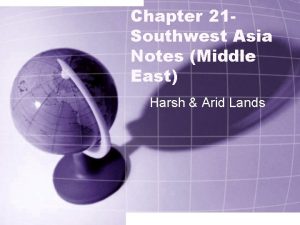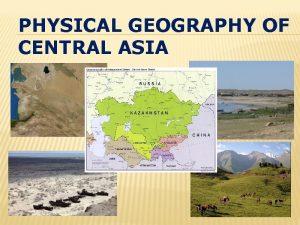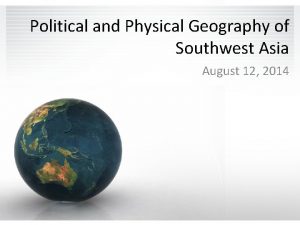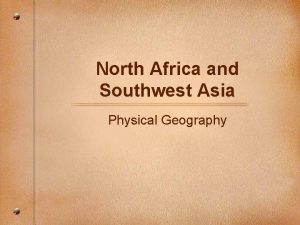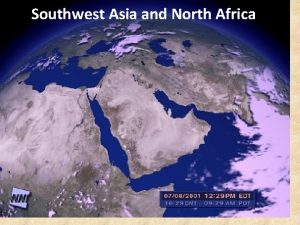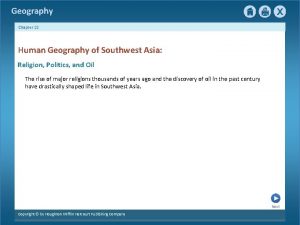Physical Geography of Southwest Asia Harsh and Arid





















































- Slides: 53

Physical Geography of Southwest Asia: Harsh and Arid Lands • Southwest Asia’s land is mostly arid or desert. The region is defined by the resource it lacks— water, and the one it has in abundance—oil.

Southwestern Asian Countries and Capitals • • • • Afghanistan: Kabul Bahrain: Manama Cyprus: Nicosia Iran: Tehran Iraq: Baghdad Israel: Jerusalem Jordan: Amman Kuwait: Kuwait City Lebanon: Beirut Oman: Muscat Qatar: Doha Saudi Arabia: Riyadh Syria: Damascus Turkey: Ankara United Arab Emirates: Abu Dhabi Yemen: Sanaa


Section 1 Landforms and Resources • The Southwest Asian landforms have had a major impact on movement in the region. • The most valuable resources in Southwest Asia are oil and water.

Landforms and Resources Landforms Divide the Region Shifting Plates • Southwest Asia forms a land bridge between Asia, Africa, Europe • Region is at edge of a huge tectonic plate - parts of Arabian Peninsula are pulling away from Africa - parts of Anatolian Peninsula are sliding past parts of Asia - other plates are pushing up mountains in other parts of Asia

continued Landforms Divide the Region Peninsulas and Waterways • Arabian Peninsula lies between Red Sea and Persian Gulf • Red Sea covers a rift valley created by Arabian plate movement • Zagros, Elburz, Taurus mountains at north side cut off part of region • Anatolian Peninsula (Turkey) is between Black and Mediterranean seas • Strategic waterways include Suez Canal from Red Sea to Mediterranean - Bosporus and Dardenelles straits connect to Russia, Asia

• Landforms Divide the Region. • Arabian Peninsula sits in between the Red Sea and the Persian Gulf.

• • Bosporus Strait Dardanelles Strait

continued Landforms Divide the Region Plains and Highlands • Arabian Peninsula is covered by dry, sandy, windy plains - wadis—riverbeds that are dry except in rainy season • Iran has stony, salty, sandy desert plateau surrounded by mountains • Anatolian Peninsula is plateau with some agriculture, grazing • Afghanistan’s Northern Plain is farming area surrounded by mountains • Golan Heights (Al Jawlan)—plateau near Jordan River, Sea of Galilee - site of conflict due to strategic location

A wadi in Saudi Arabia

continued Landforms Divide the Region Mountains • Afghanistan’s Hindu Kush Mountains help frame southern Asia - country is isolated by its landlocked, mountainous terrain • Iran’s Zagros Mountains isolate it from rest of Southwest Asia - Elburz Mountains cut Iran off from the Caspian Sea • Taurus Mountains separate Turkey from rest of Southwest Asia • Goods, people, ideas move through region in spite of mountains

continued Landforms Divide the Region Water Bodies • Region is surrounded by bodies of water; few rivers flow all year • The Tigris and the Euphrates rivers flow through Turkey, Syria, Iraq - Fertile Crescent supported several ancient civilizations - parallel rivers meet at Shatt al Arab, empty into Persian Gulf • Jordan River flows from Lebanon’s Mt. Hermon between Israel, Jordan • Empties into Dead Sea—landlocked salt lake that only bacteria live in - lowest place on earth’s exposed crust: 1, 349 feet below sea level

Tigris River

Euphrates River

Mesopotamia

• Dead Sea- landlocked salt lake – So salty that only bacteria lives in it – Lowest place on the exposed surface of the earth. • 1349 feet below sea level


Resources for a Modern World An Oil-Rich Region • Oil is region’s most abundant resource - oil fields located in Arabian Peninsula, Iran, Iraq - provide major part of those nations’ income • Half of the world’s oil reserves are in Southwest Asia - found along Persian Gulf coast or at offshore sites • U. S. and many other countries depend on oil reserves

continued Resources for a Modern World Other Resources • In some parts of region, the most valuable resource is water • Water is relatively plentiful in Turkey, Iran, Lebanon, Afghanistan - harnessed for hydroelectric power • In other regions, water is scarce; must be guarded, conserved • Coal, copper, potash, phosphate deposits mostly small, scattered - Iran, Turkey have large coal deposits - salts like calcium chloride around Dead Sea have not been developed

Climate and Vegetation • Most of Southwest Asia has a very arid climate. • Irrigation is critical to growing crops in this very dry region.

Climate and Vegetation Variety in Arid Lands Mostly Dry and Desert, but Some Green • Most areas get less than 18 inches of precipitation a year • Rough, dry terrain includes sand dunes, salt flats • Rivers don’t flow all year; plants, animals live on little water - in many areas irrigation turns desert into farmland • Other areas have Mediterranean climate; green, lush part of each year • Mountain ranges and plateaus have highland climates


Deserts Limit Movement Sandy Deserts • Rub al-Khali—Arabian Peninsula desert, known as the Empty Quarter - 250, 000 square miles, with dunes as high as 800 feet - 10 years can pass without rain • Nearby An-Nafud Desert contains the occasional oasis - desert area where underground spring water supports vegetation • Syrian Desert is between Lebanon, Israel, Syria, and Fertile Crescent • Israel’s Negev Desert produces crops through irrigation

• Rub Al-Khali • “Empty Quarter”= “place where no one comes out” • Size of Texas • One of largest sandy deserts in world, dunes can reach 800 ft tall • Surface temps, can reach 150° • 10 years may pass w/out rain

continued Deserts Limit Movement Salt Deserts • In Iran, high mountains block rain; dry winds increase evaporation - loss of moisture in soil leaves chemical salts, creates salt flat • Iran’s salt flat deserts: - Dasht-e Kavir in central Iran - Dasht-e Lut in eastern Iran • Land is salt-crusted, surrounded by salt marshes, very hot - almost uninhabited, it’s a barrier to easy travel across Iran

Salt Deserts • Iran in rain-shadow • Winds w/ no rain evaporate moisture in soil • Chemical salt is left • Salt Flat

Salt Deserts • Dasht-e Kavir • Central Iran • Salt crusted land surrounded by quick-sandlike salt marshes • Extremely hot • Act as barriers

Semi-Arid Lands The Edge of the Desert • Fringes of deserts have semiarid climate • Warm to hot summers; enough rainfall for grasses, shrubs - cotton and wheat can be grown • Good pasture for animals - herds of mohair goats raised in Turkey - mohair and fabrics from it are among Turkey’s exports

Semiarid Lands • Located on fringes of deserts • Eastern Turkey • Hot summers • Good rainfall • Pastures for animal grazing • Mohair goats in Turkey

Well-Watered Coast Lands The Mediterranean Coast • Areas along Mediterranean coast and in Turkey have adequate rainfall - hot summers, rainy winters promote citrus fruits, olives, vegetables • Mild winters and summer irrigation let farmers grow crops all year • Areas are heavily populated due to comfortable climate The Tigris and Euphrates • River valleys the site of intensive farming for thousands of years - Turkey, Iraq built dams on rivers to provide irrigation all year

Coastal Lands • Mediterranean Climate • Most of Turkey • Hot summer, rainy winter • Citrus fruits, olives, vegetables • Grow year round • Heavily populated in Turkey

Human-Environment Interaction • Water is critical to regional physical survival and economic development. • Discovery of oil increased the global economic importance of Southwest Asia.

Human-Environment Interaction Providing Precious Water Dams and Irrigation Systems • Large farms and growing populations require dams, irrigation - Turkey is building dams and a man-made lake on upper Euphrates - controversial project will deprive downstream countries of water • Israel’s National Water Carrier project - takes water from northern areas - carries it to central, south, Negev Desert - water flows through several countries so project creating conflict

continued Providing Precious Water Modern Water Technology • Drip irrigation—small pipes slowly drip water just above ground • Desalinization removes salt from ocean water at treatment plants - plants are expensive, cannot provide enough water • Wastewater can be treated and used for agriculture • Fossil water is pumped from underground aquifers - water has been in aquifer for long periods of time - rainfall won’t refill aquifers; only 25– 30 years of usage remain

Oil From the Sand Forming Petroleum • Oil, natural gas deposits formed millions of years ago - sea covered area; remains of plants, animals mingled in sand, mud - pressure and heat slowly transformed material into hydrocarbons • Oil, gas are not in underground pools, but in the tiny pores of rocks - nonporous rock barriers trap gas, oil below surface - makes oil difficult to find, remove - wasn’t found in region until 1920– 30 s

continued Oil From the Sand Early Exploration • Industrialization, automobiles increase need for petroleum • First oil discovery in region was in 1908 in Persia (now Iran) - more oil fields found in Arabian Peninsula, Persian Gulf in 1938 • In 1948, al-Ghawar field discovered at eastern edge of Rub al-Khali - became one of world’s largest oil fields - contains one-quarter of Saudi Arabia’s oil reserves

continued Oil From the Sand Transporting Oil • Crude oil is petroleum that has not been processed - refinery converts crude oil into useful products • Pipelines move crude oil to refineries, ports - ports on Persian Gulf, Red Sea, Mediterranean Sea - tankers carry petroleum to world markets • In some places refineries process crude oil near ports

continued Oil From the Sand Risks of Transporting Oil • Largest oil spill was in January 1991, during Persian Gulf War - Kuwaiti tankers, oil storage tanks were blown up - 240 million gallons of crude oil spilled into water, land • Buried pipelines reduce accidents; are monitored for leaks • Tankers are a high pollution risk; operate in shallow, narrow waters - double hulls help prevent some spills

Sulemaniye Mosque Turkey

Syria Damascus Umayyad Mosque

Parliament Square in Beirut Lebanon

Tel Aviv Dead Sea Salt Beds Negev Desert Israel Dome of the Rock

Jordan Abdullah Mosque Amman One of the new 7 wonders of the world Petra King Abdullah II

Alnidae Mosque Iraq Baghdad Tigris River

King Fahd Empty Quarter Saudi Arabia

Iran Shahid Motahari Mosque Tehran

Sanaa Yemen

Mosque Oman Sultan’s Palace

Abu Dhabi United Arab Emirates

United Arab Emirates

Police Cars in Dubai

Museum Doha Qatar Desert

Kuwait Water Towers Kuwait City Oil wells on fire
 Chapter 21 harsh and arid lands
Chapter 21 harsh and arid lands North africa and southwest asia physical geography
North africa and southwest asia physical geography Chapter 21 physical geography of southwest asia
Chapter 21 physical geography of southwest asia Peninsulas and waterways in southwest asia
Peninsulas and waterways in southwest asia Southwest asia/north africa (swana) political map
Southwest asia/north africa (swana) political map Southwest asia and north africa physical map
Southwest asia and north africa physical map Chapter 22 human geography of southwest asia
Chapter 22 human geography of southwest asia Human geography of the middle east
Human geography of the middle east Southwest asia and north africa map
Southwest asia and north africa map Nationalism in india and southwest asia
Nationalism in india and southwest asia Christianity vs judaism vs islam chart
Christianity vs judaism vs islam chart Physical map of swana
Physical map of swana Nationalism in india and southwest asia
Nationalism in india and southwest asia Nationalism in india and southwest asia
Nationalism in india and southwest asia North africa and southwest asia mountains
North africa and southwest asia mountains Asia geography
Asia geography Physical geography of east asia
Physical geography of east asia China population density
China population density Chapter 15 lesson 1 physical geography of north africa
Chapter 15 lesson 1 physical geography of north africa Physical geography of east asia
Physical geography of east asia Climate zones of asia
Climate zones of asia Brain wrinkles southwest asia
Brain wrinkles southwest asia Chapter 21 section 1 landforms and resources
Chapter 21 section 1 landforms and resources How would you describe this
How would you describe this What is the relative location of southwest asia?
What is the relative location of southwest asia? Agricultural hearths
Agricultural hearths Brain wrinkles southwest asia answer key
Brain wrinkles southwest asia answer key Voluntary trade comprehension check
Voluntary trade comprehension check Se asian economics comprehension check
Se asian economics comprehension check Site:slidetodoc.com
Site:slidetodoc.com Southwest asia landforms
Southwest asia landforms Jordan river southwest asia map
Jordan river southwest asia map Nationalism in southwest asia
Nationalism in southwest asia Europe partitioning in southwest asia answer key
Europe partitioning in southwest asia answer key Geography of sw asia color by number
Geography of sw asia color by number Southwest asia map kuwait
Southwest asia map kuwait Which ethnic group is most numerous in southwest asia
Which ethnic group is most numerous in southwest asia Southwest asia ethnic groups
Southwest asia ethnic groups Water pollution and unequal distribution illustration
Water pollution and unequal distribution illustration Why is water pollution of great concern in southwest asia
Why is water pollution of great concern in southwest asia Southwest asia vegetation
Southwest asia vegetation Ethnic groups cloze notes 1 answer key
Ethnic groups cloze notes 1 answer key Environmental issues in southwest asia
Environmental issues in southwest asia Chapter 23 today's issues southwest asia
Chapter 23 today's issues southwest asia Harsh moolani
Harsh moolani Rabindranath tagore poem taj mahal
Rabindranath tagore poem taj mahal Harsh gupta md
Harsh gupta md Harsh manchanda
Harsh manchanda Harsh golwala
Harsh golwala Explain the mutual obligations of the feudal system
Explain the mutual obligations of the feudal system Harsh kalra
Harsh kalra Iklim arid dan humid
Iklim arid dan humid Iklim arid dan humid
Iklim arid dan humid Hot semi arid grassland
Hot semi arid grassland
